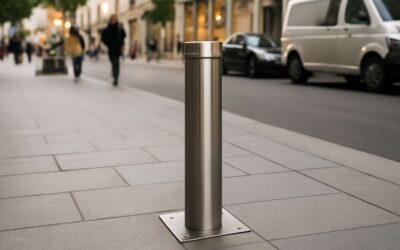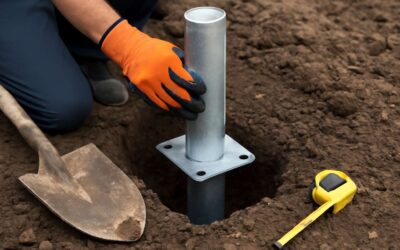
Bollards serve many functions in modern street- and sidewalk-scapes, guiding traffic and marking boundaries, as well as providing an architectural element. They are available in a number of materials, ranging from concrete to metal and plastic, with some designs being more decorative than others. While they are often seen as a visual deterrent to vehicular incursion, their most important characteristic is the ability to stop impact.
Traditional bollards are generally made of iron, and while they may not be as visually appealing as contemporary styles, their assertive appearance is still a solid deterrent to automobiles. They can be found in a number of decorative, classically designed styles that compliment a wide range of architecture. Iron is a durable material, but it will oxidize with exposure to the elements. To reduce maintenance, it can be powder coated in a dark shade to protect against rust and corrosion.
Some of the most popular, and functional, bollards are constructed of concrete. This material can be molded to achieve a number of designs and shapes, and it is highly resistant to impact damage. It can also be colored or stamped for additional aesthetic enhancements, and it is available in a variety of finishes. Concrete is relatively low maintenance; however, if the surface of a concrete bollard becomes worn or scratched it will need to be repainted.
Another common bollard material is steel. This is commonly used in decorative, modern styles for standalone applications or as covers over security pipe. Typically, it is machined from prefabricated materials rather than cast. It is less likely to oxidize than standard iron or ductile iron, and it can be powder coated to provide protection from rust and corrosion.
Other popular bollard materials include aluminum, steel composites and polyurethane. Unlike the more decorative concrete options, these are designed for functionality over design; they are often utilized when cost and durability take precedence over aesthetic concerns. They can be found in a number colors and designs, and they are easily installed and removed for changing access requirements.
While some people simply use a piece of weld pipe to create their own bollard, this approach tends to be unattractive. A better solution is to purchase a concrete bollard that has been precast. This eliminates the need for paint and provides a durable finish that will not require repainting or other maintenance.
Whether they are used as a visual or physical deterrent, a properly placed bollard is essential to any public space. Their placement must be specific to the needs of the site and comply with any governing requirements. Bollards are most effective when they are installed in groups, with each one strategically positioned to visually collapse spaces and draw lines that announce the expectation of traffic behavior. While the most common bollard locations are in front of businesses and government buildings, they can be found throughout urban centers to mark permeable or permanent boundaries. In addition to increasing safety and reducing liability, these installations can improve livability and contribute to sustainability goals.


0 Comments